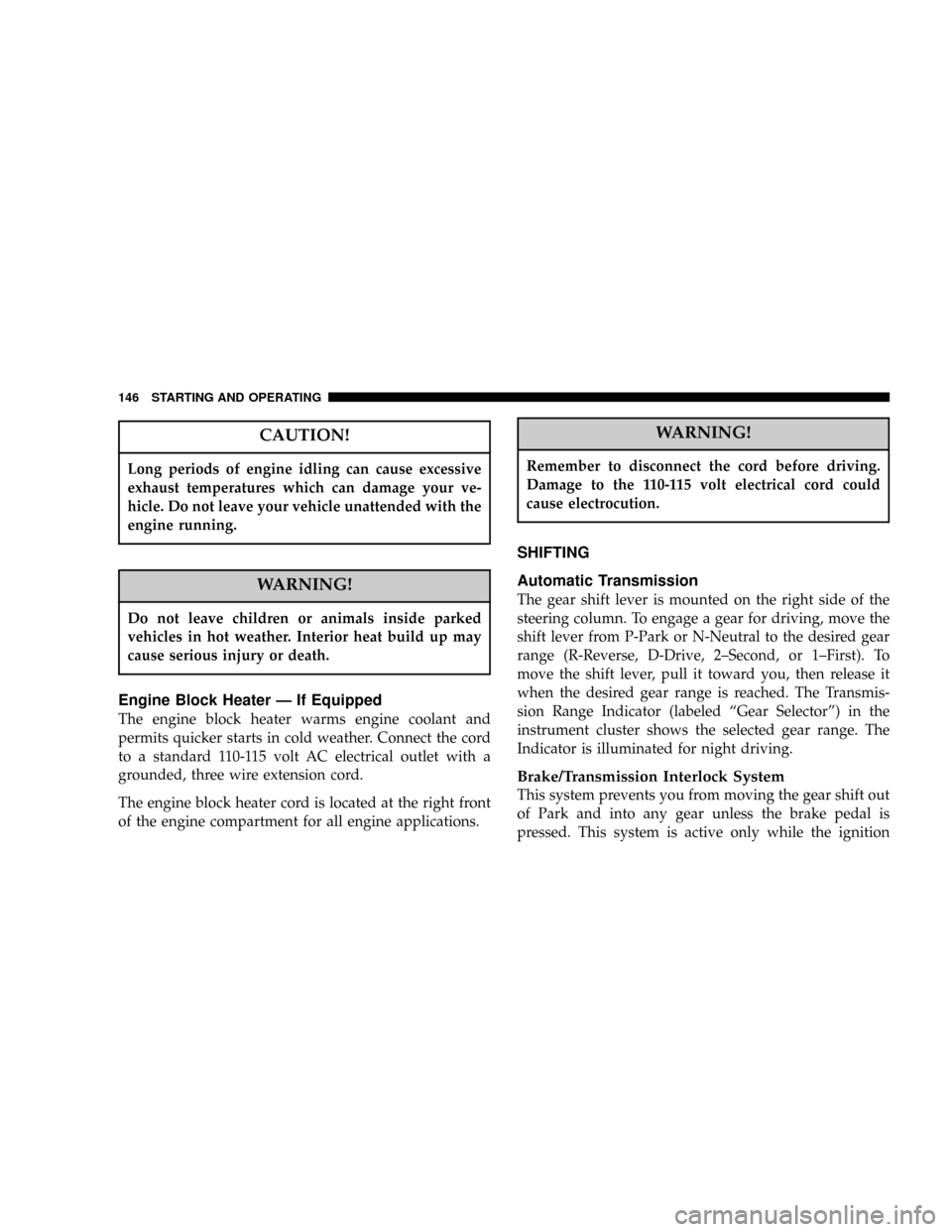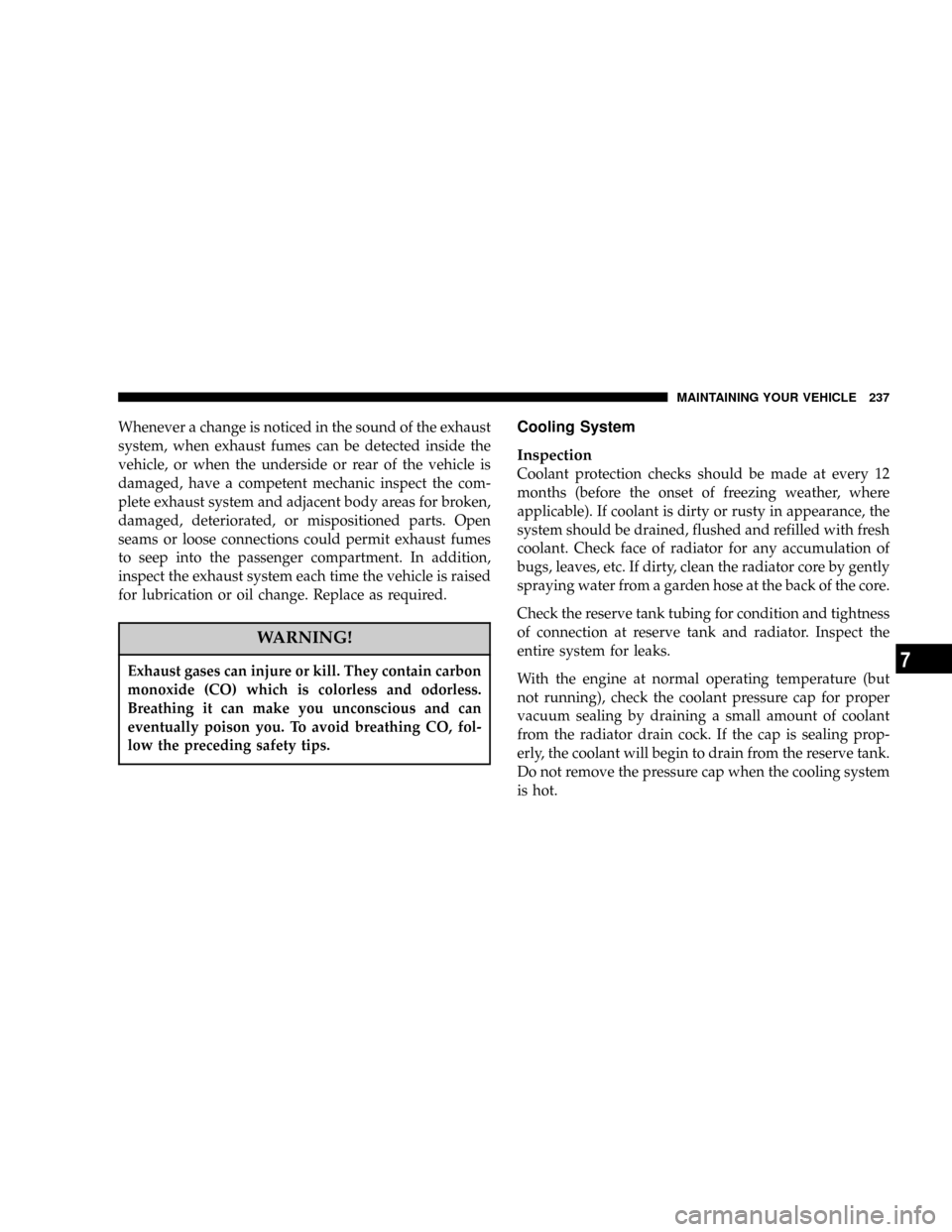2004 DODGE DAKOTA coolant temperature
[x] Cancel search: coolant temperaturePage 99 of 300

INSTRUMENT CLUSTER DESCRIPTION
1. Engine Coolant Temperature Gage
The temperature gage indicates engine coolant
temperature. Any reading within the normal
range indicates that the cooling system is oper-
ating satisfactorily. The gage needle in V6 and V8
engines will likely indicate a high temperature when
driving in hot weather, up mountain grades, in heavy
traffic, or when towing a trailer. If the needle rises to
260É (hot mark), stop the vehicle, shift into N (Neutral)
and elevate engine speed for 2-3 minutes. If the
temperature reading does not return to normal, seek
authorized service immediately.
CAUTION!
Do not leave your vehicle unattended with the
engine running as you would not be able to react to
the temperature indicator if the engine overheats.
The gage pointer will remain near its last reading when
the engine is turned off. It will return to a true reading
when the engine is restarted.
2. Voltage Gage ± If Equipped
When the engine is running, the gage will
indicate the electrical system voltage. During
normal electrical load, the pointer will remain near the
center of the scale. If the pointer moves to either the
high or low sections, and remains there during normal
driving, the electrical system should be serviced.
3. Tachometer
This gage measures engine revolutions per minute (rpm
x 1000).
4. Shift Indicator Light
A small triangle lights to signal the most economical shift
point for vehicles equipped with a manual transmission.
See the Manual Transmission Operating description in
section 5 of this manual for details.
5. Turn Signal Indicators
When a turn signal is activated, a right-pointing or
left-pointing arrow lights up and flashes to indicate the
INSTRUMENT PANEL AND CONTROLS 99
4
Page 104 of 300

U.S. federal regulations require that upon transfer of
vehicle ownership, the seller certify to the purchaser the
correct mileage that the vehicle has been driven. There-
fore, if the odometer reading is changed during repair or
replacement, be sure to keep a record of the reading
before and after the service so that the correct mileage can
be determined.
The trip odometer shows individual trip mileage. To
toggle between the odometer and the trip odometer,
press the Odometer/Trip Odometer Button.
27. Cruise Light
This indicator lights when the electronic speed control
system is turned on.
28. Coolant Temperature Light (Clusters Without A
Gauge)
This light warns of an overheated engine con-
dition. For a bulb check, this light will come on
momentarily when the ignition is turned On. If
the light turns on while driving, stop the vehicle and
shut off the engine as soon as possible.
CAUTION!
Driving with a hot engine cooling system could
damage your vehicle. If the temperature light is on,
pull over and stop the vehicle. Idle the vehicle with
the air conditioner turned off until the light turns
off. If the if the light remains on, turn the engine off
immediately, and call for service.
WARNING!
A hot engine cooling system is dangerous. You or
others could be badly burned by steam or boiling
coolant. You may want to call a service center if your
vehicle overheats. If you decide to look under the
hood yourself, see Section 7 of this manual. Follow
the warnings under the Cooling System Pressure
Cap paragraph.
104 INSTRUMENT PANEL AND CONTROLS
Page 146 of 300

CAUTION!
Long periods of engine idling can cause excessive
exhaust temperatures which can damage your ve-
hicle. Do not leave your vehicle unattended with the
engine running.
WARNING!
Do not leave children or animals inside parked
vehicles in hot weather. Interior heat build up may
cause serious injury or death.
Engine Block Heater Ð If Equipped
The engine block heater warms engine coolant and
permits quicker starts in cold weather. Connect the cord
to a standard 110-115 volt AC electrical outlet with a
grounded, three wire extension cord.
The engine block heater cord is located at the right front
of the engine compartment for all engine applications.
WARNING!
Remember to disconnect the cord before driving.
Damage to the 110-115 volt electrical cord could
cause electrocution.
SHIFTING
Automatic Transmission
The gear shift lever is mounted on the right side of the
steering column. To engage a gear for driving, move the
shift lever from P-Park or N-Neutral to the desired gear
range (R-Reverse, D-Drive, 2±Second, or 1±First). To
move the shift lever, pull it toward you, then release it
when the desired gear range is reached. The Transmis-
sion Range Indicator (labeled ªGear Selectorº) in the
instrument cluster shows the selected gear range. The
Indicator is illuminated for night driving.
Brake/Transmission Interlock System
This system prevents you from moving the gear shift out
of Park and into any gear unless the brake pedal is
pressed. This system is active only while the ignition
146 STARTING AND OPERATING
Page 237 of 300

Whenever a change is noticed in the sound of the exhaust
system, when exhaust fumes can be detected inside the
vehicle, or when the underside or rear of the vehicle is
damaged, have a competent mechanic inspect the com-
plete exhaust system and adjacent body areas for broken,
damaged, deteriorated, or mispositioned parts. Open
seams or loose connections could permit exhaust fumes
to seep into the passenger compartment. In addition,
inspect the exhaust system each time the vehicle is raised
for lubrication or oil change. Replace as required.
WARNING!
Exhaust gases can injure or kill. They contain carbon
monoxide (CO) which is colorless and odorless.
Breathing it can make you unconscious and can
eventually poison you. To avoid breathing CO, fol-
low the preceding safety tips.
Cooling System
Inspection
Coolant protection checks should be made at every 12
months (before the onset of freezing weather, where
applicable). If coolant is dirty or rusty in appearance, the
system should be drained, flushed and refilled with fresh
coolant. Check face of radiator for any accumulation of
bugs, leaves, etc. If dirty, clean the radiator core by gently
spraying water from a garden hose at the back of the core.
Check the reserve tank tubing for condition and tightness
of connection at reserve tank and radiator. Inspect the
entire system for leaks.
With the engine at normal operating temperature (but
not running), check the coolant pressure cap for proper
vacuum sealing by draining a small amount of coolant
from the radiator drain cock. If the cap is sealing prop-
erly, the coolant will begin to drain from the reserve tank.
Do not remove the pressure cap when the cooling system
is hot.
MAINTAINING YOUR VEHICLE 237
7
Page 239 of 300

CAUTION!
Mixing of coolants other than specified (non-
HOAT), may result in engine damage that may not
be covered under the new vehicle warranty, and
decreased corrosion protection. If a non-HOAT cool-
ant is introduced into the cooling system in an
emergency, it should be replaced with the specified
coolant as soon as possible.
Do not use plain water alone or alcohol base anti-
freeze products. Do not use additional rust inhibi-
tors or antirust products, as they may not be compat-
ible with the radiator coolant and may plug the
radiator.
This vehicle has not been designed for use with
Propylene Glycol based coolants. Use of Propylene
Glycol based coolants is not recommended.
Adding Coolant
When adding coolant or refilling system, a 50% solution
of ethylene glycol antifreeze coolant in water should beused. Higher concentrations (not to exceed 65%) are
required if temperatures below ±37ÉF (± 38ÉC) are antici-
pated.
Use only high purity water such as distilled or deionized
water when mixing the water/antifreeze solution. The
use of lower quality water will reduce the amount of
corrosion protection in the engine cooling system.
Please note that it is the owner's responsibility to main-
tain the proper level of protection against freezing ac-
cording to the temperatures occurring in the area where
the vehicle is operated.
WARNING!
Never add coolant to the radiator when the engine is
overheated. Do not loosen or remove pressure cap to
cool overheated engine. The coolant is under pres-
sure and severe scalding could result.
MAINTAINING YOUR VEHICLE 239
7
Page 240 of 300

Coolant Pressure Cap
The coolant pressure cap must be fully tightened to
prevent loss of coolant, and to insure that coolant will
return to the radiator from the coolant reserve tank.
The pressure cap should be inspected and cleaned if there
is any accumulation of foreign material on the sealing
surfaces.
WARNING!
The warning words ªDO NOT OPEN HOTº on the
coolant pressure cap are a safety precaution. Heat
causes pressure to build up in the cooling system. To
prevent scalding or injury, do not remove the pres-
sure cap when the system is hot or under pressure.
Coolant Level
The coolant reserve system provides a quick visual
method for determining that the coolant level is ad-
equate. With the engine idling, and warmed to normal
operating temperature, remove the cap from the over-
flow bottle, remove the dipstick and wipe the excess
coolant from it. Reinsert the dipstick and remove. Ob-
serve the dipstick checking the holes along the stem for
coolant. Check the coolant level whenever the hood is
raised.
240 MAINTAINING YOUR VEHICLE
Page 290 of 300

Compact Disc Maintenance............... 132
Compact Disc Player.................106,110
Compact Spare Tire..................... 178
Compass.............................. 79
Compass Calibration...................79,80
Computer, Trip/Travel.................... 77
Console, Floor.......................... 88
Console, Overhead....................... 76
Contract, Service....................... 282
Converter, Catalytic..................... 189
Coolant Pressure Cap.................... 240
Cooling System.....................237,240
Adding Coolant (Antifreeze)............. 239
Coolant Capacity..................... 258
Coolant Level........................ 240
Disposal of Used Coolant............... 238
Drain, Flush, and Refill................. 238
Inspection........................... 237
Points to Remember................... 241
Radiator Cap........................ 240
Selection of Coolant.............238,258,259
Temperature Gauge.................... 99
Cruise Control.......................... 74Cruise Light........................... 104
Cup Holder............................ 89
Customer Assistance.................... 280
Daytime Running Lights.................. 69
Dealer Service......................... 225
Defroster, Rear Window.................. 140
Defroster, Windshield...............54,133,136
Delay Wipers........................... 71
Diagnostic System, Onboard............... 223
Differential, Limited-Slip................. 162
Dimmer Switch, Headlight................ 100
Dipsticks
Automatic Transmission................ 245
Oil (Engine)......................... 226
Power Steering....................... 234
Disabled Vehicle Towing................. 217
Disc Brakes........................... 243
Disposal
Used Coolant........................ 238
Door Ajar............................ 103
Door Locks..........................13,14
Door Opener, Garage..................... 81
290 INDEX
Page 291 of 300

Downshifting.......................... 151
Drive Belts............................ 230
Drive Shaft Universal Joints............... 235
Electrical Power Outlets................... 86
Electronic Power Distribution Center........ 252
Electronic Speed Control.................. 74
Emergency, In Case of
Freeing Vehicle When Stuck............. 167
Jacking............................. 211
Jump Starting........................ 215
Overheating......................... 239
Towing............................. 217
Emission Control System Maintenance....... 262
Emission Related Components............. 241
Engine
Air Cleaner.......................... 231
Air Cleaner Filter..................... 230
Block Heater......................... 146
Break-In Recommendations............... 52
Compartment.....................221,222
Coolant..........................238,259
Cooling............................ 237Exhaust Gas Caution................53,189
Fails to Start......................... 145
Flooded, Starting..................... 145
Fuel Requirements.................... 258
Oil ..........................226,258,259
Oil Selection......................... 258
Oil Synthetic......................... 229
Overheating......................... 239
Starting............................ 144
Temperature Gauge.................... 99
Entry System, Illuminated................. 12
Equipment Identification Plate............. 206
Exhaust Gas Caution..................53,237
Exhaust System......................53,236
Exterior Lighting........................ 68
Filters
Air Cleaner.......................... 230
Engine Fuel......................... 231
Engine Oil.......................229,259
Engine Oil Disposal................... 229
Flashers
Hazard Warning...................... 208
INDEX 291
10